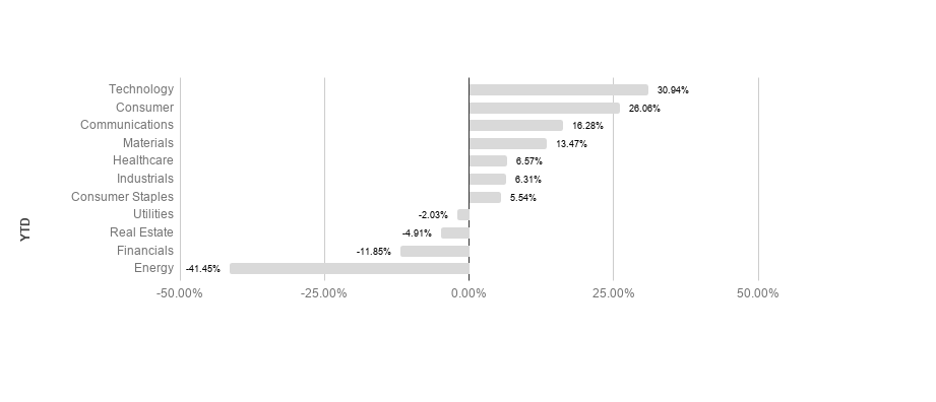Stocks were mixed this week as pharmaceutical company Moderna became the second company in as many weeks to have a high success rate with their COVID-19 vaccine trials. Globally, COVID-19 infections continue to increase. New daily infections in the U.S. remain above 100K. Economic data was mixed this week with retail sales coming in under expectations, but with housing and manufacturing beating expectations. Unemployment claims have been choppy but moving downwards, likely indicating slowly recovering labor markets. Recently, unemployment declines have slowed somewhat, prompting questions as to whether or not the recovery may be coming to a halt. The persistently high and increasing case rates of COVID-19 in the U.S. remain concerning, and restrictive measures have begun being reinstated in some areas. The increase in cases has been statistically correlated with schools reopening, and as the flu season sets in transmission rates may increase even further.
Overseas, developed markets and emerging markets both rose. Global indices took very well to reports of an effective vaccine, likely increasing hopes that lockdowns in Europe could be ended sooner than later.
Markets were mixed this week, with equity indices bringing in varying returns. Fears concerning global stability and health are an unexpected factor in asset values, and the recent volatility serves as a great reminder of why it is so important to remain committed to a long-term plan and maintain a well-diversified portfolio. When stocks were struggling to gain traction last month, other asset classes such as gold, REITs, and US Treasury bonds proved to be more stable. flashy news headlines can make it tempting to make knee-jerk decisions, but sticking to a strategy and maintaining a portfolio consistent with your goals and risk tolerance can lead to smoother returns and a better probability for long-term success.
Chart of the Week

The percentage of global bonds with yields below 0% have reached new record highs, surpassing the previous record set in 2019 at north of $17 trillion. This recent trend likely highlights a high degree of risk aversion in fixed income markets.
Market Update
Equities
Broad market equity indices finished the week mixed, with major large cap indices underperforming small cap. Economic data has been solid, but the global recovery is still threatened by COVID-19.
S&P sectors returned mixed results this week. Energy and materials outperformed, returning 4.99% and 1.06% respectively. Healthcare and utilities underperformed, posting -3.00% and -3.92% respectively. Technology leads the pack so far YTD, returning 30.94% in 2020.


Commodities
Commodities rose this week, driven by a jump in oil prices. Oil markets have begun to show a significant responsiveness to the status of vaccine development efforts, as normal economic conditions are critical to energy consumption. Energy markets have been highly volatile, with oil investors focusing on output and consumption concerns. Demand is still likely to recover slowly however, and recent lockdown restrictions in Europe have raised doubts as to whether demand is going to continue in a positive direction. On the supply side, operating oil rigs are still well under early 2020 numbers, but trending upwards.
Gold fell slightly this week even as the U.S. dollar weakened. Gold is a common “safe haven” asset, typically rising during times of market stress. Focus for gold has shifted to global macroeconomics and recovery efforts.
Bonds
Yields on 10-year Treasuries fell this week from 0.896% to 0.82% while traditional bond indices rose. Treasury yield movements reflect general risk outlook, and tend to track overall investor sentiment. Treasury yields will continue to be a focus as analysts watch for signs of changing market conditions.
High-yield bonds rose this week as spreads tightened. High-yield bonds are likely to remain volatile in the short to intermediate term as the Fed has adopted a remarkably accommodative monetary stance and investors warm slightly to economic risk factors, likely driving increased volatility.

Lesson to Be Learned
“The individual investor should act consistently as an investor and not as a speculator. This means … that he should be able to justify every purchase he makes and each price he pays by impersonal, objective reasoning that satisfies him that he is getting more than his money’s worth for his purchase.”
-Ben Graham
We have two simple indicators we share that help you see how the economy is doing (we call this the Recession Probability Index, or RPI), as well as if the US Stock Market is strong (bull) or weak (bear).
In a nutshell, we want the RPI to be low on a scale of 1 to 100. For the US Equity Bull/Bear indicator, we want it to read at least 66.67% bullish. When those two things occur, our research shows market performance is typically stronger, with less volatility.
The Recession Probability Index (RPI) has a current reading of 28.43, forecasting a lower potential for an economic contraction (warning of recession risk). The Bull/Bear indicator is currently 100% bullish, meaning the indicator shows there is a slightly higher than average likelihood of stock market increases in the near term (within the next 18 months).

It can be easy to become distracted from our long-term goals and chase returns when markets are volatile and uncertain. It is because of the allure of these distractions that having a plan and remaining disciplined is mission critical for long term success. Focusing on the long-run can help minimize the negative impact emotions can have on your portfolio and increase your chances for success over time.
The Week Ahead
Due to the shortened trading week because of Thanksgiving, economic data will be a bit lighter than normal. This week will see updated durable goods orders as well as personal spending and income. Continued progress in these areas should provide encouragement for economists and analysts.
More to come soon. Stay tuned.



